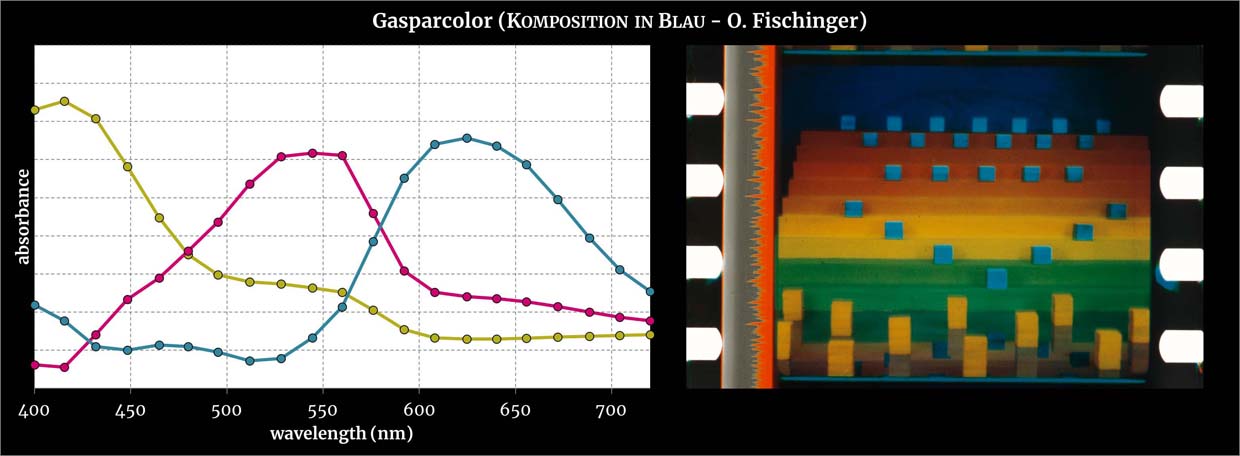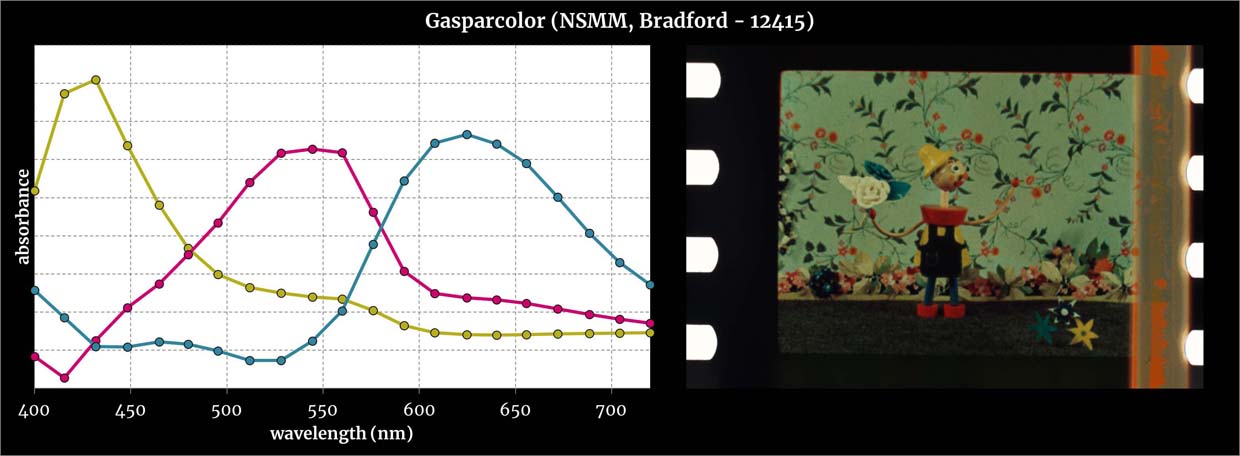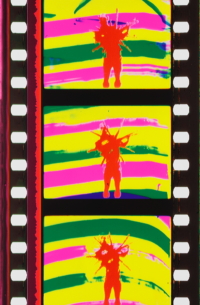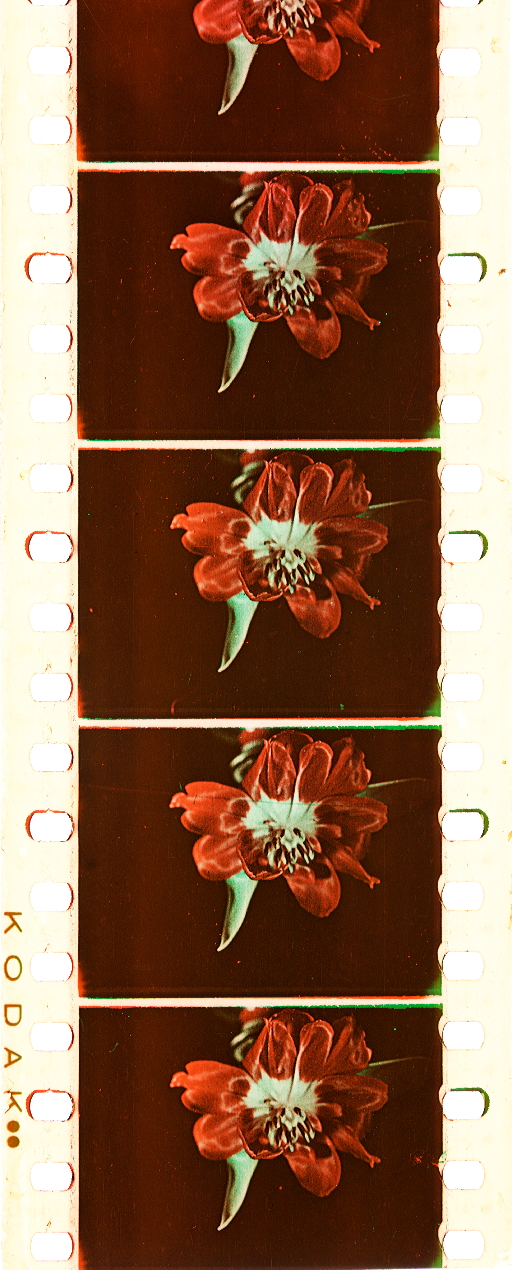Gasparcolor OR Gaspar Color
Description
Gasparcolor was the first three-color multi-layer monopack film available for practical use. It was a double-coated print film with a cyan layer on one side and two layers dyed magenta and yellow on the other side (see illustrations). As a consequence of this arrangement the process required b/w separation records of the red, blue and green light, either produced by a beam-splitter camera or by successive photographs taken through the corresponding filters. Thus most of the films produced with Gasparcolor were animation films. Gaspar’s process was chemically and optically very sophisticated and elegant. It produced brilliant and very stable colors.
The basic idea of the silver dye-bleach process was the controlled destruction of dyes in relation to the amount of developed silver present at a specific locus. Therefore the gelatin emulsions were dyed before exposure. After development the dyes were bleached by acid thiourea with the silver serving as a local catalyst for the reaction. Since the dyes are destroyed in the exposed areas Gasparcolor is a reversal process.
Although the chromolytic principle was proposed very early, many obstacles had to be resolved for a practical solution. For instance, as Gaspar pointed out, for optical reasons it was not possible to sensitize the layers to the complementary spectrum of the dyes. Therefore Gaspar chose an arbitrary connection between the colored light for exposure and the corresponding dyes such that the green separation was exposed by blue filtered light on the magenta dyed layer and subsequently the blue separation by the use of red filtered light on the yellow layer. The cyan dyed emulsion on the opposite side of the film was exposed by blue filtered light through the red separation print (see illustrations). The yellow layer acted as a filter to block out the blue light from both sides.
For political reasons Gaspar had to flee from Germany before the Second World War. While he established a plant in London, he could not convince the producers in the US to adopt his process. In the late 1950s, however, the principle was revived by Ciba-Geigy and distributed as Cibachrome (later Ilfochrome) for photographic paper prints.
Gasparcolor prints can be identified by the emulsion layers on both sides of the film. In case of scratches or cuts the colors of the layers become visible (see illustration). In addition, the sound track is often printed in color.
-
![]()
Uit het rijk der kristallen (NDL 1927?, J.C. Mol). Credit: EYE Film Museum. Photographs of the Dufaycolor and Gasparcolor nitrate print by Barbara Flueckiger.
-
![]()
Kreise (English title Circles) (Oskar Fischinger, GER 1933-34) Oskar Fischinger’s own nitrate print. Credit: Library of Congress, (c) Fischinger Trust, courtesy Center for Visual Music. Photograph Fischinger’s own nitrate print by Barbara Flueckiger.
-
![]()
Credit: (c) Fischinger Trust, courtesy Center for Visual Music. Film: Allegretto by Oskar Fischinger (1936-1943).
-
![]()
Credit: (c) Fischinger Trust, courtesy Center for Visual Music. Film: Gasparcolor tests by Oskar Fischinger, c. 1933-34.
-
![]()
Credit: Cinémathèque suisse. Film: Komposition in Blau (Composition in Blue) AKA Lichtkonzert Nr. 1 (Light-Concert No. 1) (GER 1935, Oskar Fischinger).
-
![]()
Credit: Cinémathèque suisse. © Fischinger Trust, courtesy Center for Visual Music. Film: Komposition in Blau (Composition in Blue) AKA Lichtkonzert Nr. 1 (Light-Concert No. 1) (GER 1935, Oskar Fischinger).
-
![]()
Credit: Cinémathèque suisse. © Fischinger Trust, courtesy Center for Visual Music. Film: Komposition in Blau (Composition in Blue) AKA Lichtkonzert Nr. 1 (Light-Concert No. 1) (GER 1935, Oskar Fischinger).
-
![]()
Source: Coe, Brian (1981): The History of Movie Photography. Westfield, N.J.: Eastview Editions.
-
![]()
Color chart on Agfa Tripofilm. This was the raw stock used for Gasparcolor in Germany until about 1939. Source: Arens, Hans; Heymer, Gerd (1939): Die „Agfa-Farbentafel für Farbenphotographie“. In: Veröffentlichungen des wissenschaftlichen Zentral-Laboratoriums der photographischen Abteilung Agfa, Vol. 6, 1939, pp. 225-229. Leipzig: Hirzel. Photograph by Barbara Flueckiger.
-
![]()
Source: Pénichon, Sylvie (2013): Twentieth Century Colour Photographs. The Complete Guide to Processes, Identification & Preservation. London, Los Angeles: Thames & Hudson, p. 213.
Galleries Open all Galleries ▼
Original Technical Papers and Primary Sources
Gaspar, Béla (1935): Neuere Verfahren zur Herstellung von subtraktiven Mehrfarbenbildern (Gasparcolor-Verfahren). In: Zeitschrift für wissenschaftliche Photographie, Photophysik Photochemie, 34, pp. 119–124. (in German) View Quote
Gehret, Ernest Ch. (1964): The Cilchrome Colour Print Process. In: The British Journal of Photography, 111, Jun., pp. 480–487, on p. 480. View Quote
Klein, Major Adrian B. (1936): The Gasparcolor Process. In: International Photographer, 8,5, Jun., pp. 6–7. View Link
Secondary Sources
Agde, Günter (1998): Flimmernde Versprechen. Geschichte des Deutschen Werbefilms im Kino seit 1987. Berlin. (in German)
Alt, Dirk (2011): “Der Farbfilm marschiert!” Frühe Farbfilmverfahren und NS-Propaganda 1933-1945. München: Belleville, on pp. 49–50 View Quote, on pp. 53–54 View Quote, on p. 84 View Quote, on p. 99 View Quote, on p. 100 View Quote, on p. 107 View Quote, on p. 110 View Quote, on p. 117 View Quote, on p. 126 View Quote, on pp. 157–159 View Quote, on p. 160 View Quote, on p. 161 View Quote, on p. 188 View Quote, on pp. 197–198 View Quote, on pp. 199–200 View Quote, on p. 228 View Quote, and on p. 409. (in German) View Quote
Beyer, Friedemann; Koshofer, Gert; Krüger, Michael (2010): UFA in Farbe. Technik, Politik und Starkult zwischen 1936 und 1945. München: Collection Rolf Heyne, on pp. 49–50 View Quote, on p. 50 View Quote and on p. 51. (in German) View Quote
Brown, Simon (2012): Technical Appendix. In: Sarah Street: Colour Films in Britain. The Negotiation of Innovation 1900-55. Basingstoke, Hampshire: Palgrave Macmillan, pp. 259–287, on pp. 272–273. View Quote
Brune, Wolfgang (1954): Ein altes farbenfotografisches Verfahren unter neuen Gesichtspunkten. In: Bild und Ton, 7,10, pp. 293–295. (in German) View Quote
Cauda, Ernesto (1938): Il cinema a colori. Quaderno mensile. Roma: Bianco e nero, anno II, nr. 11, on pp. 43–45. (in Italian) View Quote
Cleveland, David; Pritchard, Brian (2015): How Films were Made and Shown. Some Aspects of the Technical Side of Motion Picture Film 1895–2015. Manningtree, Essex: David Cleveland, on pp. 213–214. View Quote
Coe, Brian (1981): The History of Movie Photography. Westfield, N.J.: Eastview Editions, p. 136. View Quote
Coote, Jack H. (1993): The Illustrated History of Colour Photography. Surbiton, Surrey: Fountain Press, pp. 183–189 on the Cibachrome process.
Cornwell-Clyne, Adrian (1951): Colour Cinematography. London: Chapman & Hall, pp. 419–427. View Quote
Dr. N. (1937a): Gasparcolor. In: Film-Kurier, 183, 2.8.1937, Serie „Farb-Film-Fibel”. (in German) View Quote
Dr. N. (1937b): Teerfarben (Anilinfarben). In: Kinotechnische Rundschau. Beilage zu Film-Kurier, 21.8.1937, Serie “Farb-Film-Fibel”. (in German) View Quote
Dr. N. (1937b): Teerfarben (Anilinfarben). In: Kinotechnische Rundschau. Beilage zu Film-Kurier, 21.8.1937, Serie “Farb-Film-Fibel”. (in German) View Quote
Eggert, John; Heymer, Gerd (1937): Der Stand der Farbenphotographie. In: Veröffentlichungen des wissenschaftlichen Zentral-Laboratoriums der photographischen Abteilung Agfa, pp. 7–28, on pp. 18–20 View Quote and on pp. 26–28. (in German) View Quote
Forster, Ralf (2005): Ufa und Nordmark. Zwei Firmengeschichten und der deutsche Werbefilm 1919-1945. Trier. (in German)
Friedman, Joseph Solomon (1945): History of Color Photography. Boston: The American Photographic Publishing Company, pp. 405–429. View Quote
Guckes, Emil (1937): Der Tonfilm als Werbemittel in Deutschland. Dissertation. Innsbruck. (in German)
Heymer, Gerd (1935): Farbenfilme nach dem Silberbleichverfahren. In: Veröffentlichungen des wissenschaftlichen Zentral-Laboratoriums der photographischen Abteilung Agfa, 4, 1935, pp. 177–186. (in German) View Quote
Huntley, John (1949): British Technicolor Films. Cornhill, London: Skelton Robinson, on p. 18 View Quote and on p. 202. View Quote
Ignatow, G. (1937): Das Gasparcolor-Verfahren zur Herstellung von Dreifarbenfilmen. In: Kinotechnik, 6, 1937, pp. 126–127. (in German)
Jakobson, K. (1933): Gasparcolor, eine Lösung des Problems der Farbenphoto- und Kinematographie. In: Die Kinotechnik, 15,15, Aug., pp. 248–249. (in German) View Quote
Koshofer, Gert (1966): Fünfundzwanzig Jahre deutscher Farbenspielfilm. In: Film – Kino – Technik, 20,10, 1966, pp. 259–262, on p. 259. (in German) View Quote
Koshofer, Gert (1981): Farbfotografie. München: Laterna Magica., Band 2: Moderne Verfahren, pp. 167, 174–177 on Cibachrome.
Koshofer, Gert (1988): Color. Die Farben des Films. Berlin: Wissenschaftsverlag Volker Spiess.
Koshofer, Gert (2018): Was war vor Agfacolor? In: Cine 8-16, 48, pp. 20–21.
Lavedrine, Bertrand (1998): History and Technology of Colour Photographic Processes. In: Luciano Berriatúa et al.: Tutti i colori del mondo. Il colore nei mass media tra 1900 e 1930. = All the colours of the world. Reggio Emilia: Edizioni Diabasis, pp. 117–119, on p. 119. View Quote
Lipton, Norman C. (2001): Gasparcolor’s Shining Hour. In: Photo Techniques, Jun., pp. 38–40. View Quote
Mees, C. E. Kenneth (1937): The Development of the Art and Science of Photography in the Twentieth Century. In: Journal of the Society of Motion Picture Engineers, 28,1, pp. 3–20, on pp. 13–14. View Quote
Meyer, Kurt (1940): Die farbenfotografischen subtraktiven Mehrschichten-Verfahren. In: Ergebnisse der angewandten physikalischen Chemie, 6,2. Leipzig: Akademische Verlagsgesellschaft, on pp. 368–370 View Quote and pp. 411–427. (In German) View Quote
Misek, Richard (2007): “Last of the Kodak”. Andrei Tarkovsky’s Struggle with Colour. In: Everett, Wendy (ed.): Questions of Colour in Cinema. From Paintbrush to Pixel. Oxford: Peter Lang, pp. 161–176, on p. 163. View Quote
Moritz, William (2004): Optical Poetry. The Life and Work of Oskar Fischinger. Bloomington: Indiana University Press, on pp. 220–221 View Quote, on pp. 222–223 View Quote, on pp. 224–225 View Quote, on pp. 226–227 View Quote and on pp. 227–229. View Quote
Pénichon, Sylvie (2013): Twentieth Century Colour Photographs. The Complete Guide to Processes, Identification & Preservation. London, Los Angeles: Thames & Hudson, on pp. 212–214. View Quote
Pinel, Vincent (1992): La forêt des techniques. In: Michel Ciment (ed.): Ciné mémoire . Colloque international d’information (7-9 octobre 1991). Paris: Femis, pp. 17–24, on pp. 21–23. (in French) View Quote
Ryan, Roderick T. (1977): A History of Motion Picture Color Technology. London: Focal Press, pp. 213–216. View Quote
Schultze, Werner (1953): Farbenphotographie und Farbenfilm. Wissenschaftliche Grundlagen und technische Gestaltung. Berlin/Göttingen/Heidelberg: Springer, pp. 92–97 (in German). View Quote
Street, Sarah (2012): Colour Films in Britain. The Negotiation of Innovation 1900-55. Basingstoke, Hampshire: Palgrave Macmillan, on pp. 45–46. View Quote
Westbrock, Ingrid (1983): Der Werbefilm. Ein Beitrag zur Entwicklungsgeschichte des Genres vom Stummfilm zum frühen Ton- und Farbfilm. Hildesheim/Zürich/New York. (in German)
Wyckoff, A. (1941): Gasparcolor Comes to Hollywood. In: American Cinematographer, 22,11, Nov., pp. 510–511. View Quote
Measurements

Dyes’ absorbances extracted with a statistical method from multispectral image capture. Credit: Giorgio Trumpy, ERC Advanced Grant FilmColors.
See the specific sample from which the spectra were extracted.

Dyes’ absorbances extracted with a statistical method from multispectral image capture. Credit: Giorgio Trumpy, ERC Advanced Grant FilmColors.
See the specific sample from which the spectra were extracted.
Films
Colour Flight (UK 1938, Len Lye) commercial5
Colour Box (GBR 1935, Len Lye)2
Birth of the Robot (GBR 1936, Len Lye)2, 5, 8
Rainbow Dance (GBR 1936, Len Lye)1, 2, 5
Musical Poster No. 1 (GBR 1940, Len Lye)
Colour on the Thames (GBR 1935, Adrian Klein)4, 6, cinematography by Adrian Cornwell-Clyne, short documentary
Opta empfängt (GER 1936, Alexandre Alexeïeff) commercial
Les deux amies (de votre beauté) (FRA 1936, Alexandre Alexeïeff)
Naissance de Vénus(FRA 1936, Alexandre Alexeïeff)
Étoiles nouvelles (FRA 1937, Alexandre Alexeïeff)
Palette d’artiste (FRA 1938, Alexandre Alexeïeff)
Kreise AKA Alle Kreise erfasst Tolirag (GER 1933, Oskar Fischinger) commercial7
Muratti greift ein (Muratti Gets in the Act) (GER 1934, Oskar Fischinger) commercial7
Allegretto (GER 1936, Oskar Fischinger) short experimental film
Komposition in Blau (Composition in Blue) AKA Lichtkonzert Nr. 1 (Light-Concert No. 1) (GER 1935, Oskar Fischinger) short experimental film
Nächtlicher Spuk (GER 1935, Wolfgang Langhoff)
Tanz der Farben (GER 1938, Hans Fischinger)
The Ship of the Ether (Netherlands 1934, George Pal) commercial
The Magic Atlas (1935, George Pal)
On Parade (GBR 1936, George Pal)2
Puppetoons (USA 1932-47, George Pal)1, 3
La Journée d’André (FRA 1936, Berthold Bartosch) commercial
Untitled commercial for shoes (GER 1936)
Untitled commercial for Blaupunkt Radiogeräte (GER)
Minimax Feuerschutz (GER, Walter Born) commercial
Purzel der Zwerg und der Riese vom Berg (GER, Kurt Stordel) animated short
Heute große Dampferfahrt (GER 1938, Hans Fischerkoesen) animated short
Was die Eiche rauscht (GER l935)
Vertrag mit der Hölle (GER 1935)
Sängerkrieg auf der Wartburg (GER 1935)
Hier fehlt etwas (GER, Walter Born) commercial for Blaupunkt Radiogeräte
Norddeutscher Lloyd Bremen (GER, Walter Born) commercial
Panik durch Ping-Pong (GER 1938, Walter Born) commercial
1 Street, Sarah (2012): Colour Films in Britain. The Negotiation of Innovation 1900-55. Basingstoke, Hampshire: Palgrave Macmillan, on pp. 45–46. View Quote
2 Huntley, John (1949): British Technicolor Films. Cornhill, London: Skelton Robinson, on p. 18. View Quote
3 Wyckoff, A. (1941): Gasparcolor Comes to Hollywood. In: American Cinematographer, 22,11, Nov., pp. 510–511. View Quote
4 Watkins, Liz (2013): Interview. Giovanna Fossati. In: Simon Brown, Sarah Street and Liz Watkins (eds.): British Colour Cinema. Practices and Theories. Hampshire: Palgrave Macmillan, pp. 228–235, on pp. 229–235.
5 Horrocks, Roger (2001): Len Lye. A Biography. Auckland University Press., on pp. 145–147 View Quote, on pp. 148–150 View Quote and on pp. 169–170. View Quote
6 Alt, Dirk (2011): “Der Farbfilm marschiert!” Frühe Farbfilmverfahren und NS-Propaganda 1933-1945. München: Belleville, on p. 110. (in German) View Quote
7 Alt, Dirk (2011): “Der Farbfilm marschiert!” Frühe Farbfilmverfahren und NS-Propaganda 1933-1945. München: Belleville, on p. 99. (in German) View Quote
8 Cleveland, David; Pritchard, Brian (2015): How Films were Made and Shown. Some Aspects of the Technical Side of Motion Picture Film 1895–2015. Manningtree, Essex: David Cleveland, on pp. 213–214. View Quote
According to an international research in filmarchives done by Andrea Krämer:
Radio Prohaska prophezeit (GER 1937) commercial
Der Kaffeeonkel kommt (GER 1937) commercial for Pfeiffer und Diller
Die Reifeprüfung (GER) commercial
Die Stichprobe (GER, Hans Fischerkoesen)
Lustig und Bunt (GER)
Wenn’s brennt (GER 1938, Walter Born) commercial for Minimax
Ali Baba and the forty thieves (NL 1935, George Pal)
The Dandelion (GB 1938, J.V. Durden)
Dolly Follies (NL 1935, George Pal)
Fun on the Farm (GB 1935, Paul Bianchi) commercial for Cadbury
Jour et nuit (FR 1935)
Opa’s Wijze Raad
Optricks (GB 1938)
Roy – Britain’s No 1 Sheep Dog (GB 1936)
Tire A Quatre Epingles (FR 1936, Alexandre Alexeïeff)
Vereinte Kraft – Schafft (GER 1940)
Die große Philips Revue (1938, George Pal) commercial for Philips
Ether Symphony (NL 1936, George Pal) commercial for Philips
In lamp light land (NL 1935, George Pal) commercial for Philips
Radio Valve Revolution (NL 1934, George Pal)
Schmoll Symphonia (HU 1938, Szenasy György, Macskassy Gyula, Kassowitz Felix) commercial for Schmoll Pasta
Serenade (NL 1938, Hendrik de Vogel)
Boldog Kiraly Kincse (HU 1936, Janos Halasz, Felix Kassowitz, Gyula Macskassy)
7 Slager (HU 1939, Macskassy Gyula, Szenasy György)
Izzo Szerelem (HU 1939, Macskassy Gyula, Szenasy György)
Feny (HU 1942, Macskassy Gyula, Szenasy György)
A Lathatatlan Vendeg (HU 1939, Macskassy Gyula, Szenasy György)
Zeusz Inkognitoban (HU 1938, Kassovitz Felix, Macskassy Gyula, Szenasy György)
Pezsgö Ritmusok (HU, Macskassy Gyula, Szenasy György)
A Szerelmes Masiniszta (HU, Kassovitz Felix, Macskassy Gyula, Szenasy György)
Hamupipöke Meses Mosasa (HU 1940, Macskassy Gyula, Szenasy György)
A Vidam Suszterinas (HU, Macskassy Gyula, Szenasy György)
Van Radioja? (HU 1940, Macskassy Gyula, Szenasy György)
Corvin (HU, Macskassy Gyula, Szenasy György)
Pink Guards on Parade (GB 1934, Oskar Fischinger)8, commercial for Euthymol Toothpaste
Das Waschgespenst (GER) commercial for Henkel
Der Fortschrittler (GER 1938, Hans Fischerkoesen)
Det er varnt at voere Rodspoette (DK, Nils Skjoldborg)
Dicke Luft (GER 1938, Hans Fischerkoesen) commercial for FEWA
Die erfrischende Pause (GER, Hans Fischerkoesen) commercial for Coca-Cola
Die Feuerprobe (GER 1935, Curt Schuhmann) commercial for Jenaer Glas
Freudiges Ereignis (GER 1936, Hans Fischerkoesen) commercial for Muratti
Hemden unter sich (GER 1937, Hans Fischerkoesen)
Katherine (GER 1938, E. Heuss – Knapp ) commercial for Nivea
Mit dem D-Zug um die Wette (GER 1938, Werner Kruse) commercial for Deutsche Reichsbahn
Morgenstunde (GER 1938, Werner Kruse) commercial for ODOL
Mystere de la Beaute (GER 1937, Wolfgang Kaskeline) commercial for 4711
Vier Asse (GER 1936, George Pal) commercial for Philips
Die Heinzelmännchen (GER, Fritz Boehner)
Ein Märchen-Erlebnisse im Wald (GER 1938, Kurt Stordel)
Das blaue Wunder (GER 1935, Hans Fischerkoesen) commercial for Muratti
Das Quellenwunder (GER 1935, Wolfgang Kaskeline)
Das tapfere Schneiderlein (GER)
In einer Nacht (GER 1938, Ewald von Tresckow)
Fernsehen (GER 1935, Hans Fischerkoesen)
Singende, klingende, farbige Harmonika (GER 1938, Ulrich Kayser)
Kaufhöfe in alter Zeit (GER 1937, Rudi Klemm) commercial for Kaufhof
The Red Box Fantasy (GB 1935, Paul Bianchi) commercial for Craven A8
De l´Or (FR 1937, Alexandre Alexeïeff)
Le Rayon vert (FR 1937, Alexandre Alexeïeff)
Langage des cartes (FR 1935, Alexandre Alexeïeff)
Carmen (AU 1935, Bruno Wozak, Karl Thomas )
Trade Tattoo (GB 1937, Len Lye)
Heute Abend habe ich Gäste (GER 1938, Wolfgang Kaskeline) commercial for Attika cigarettes
Barbe bleu (FR, Jean Painleve)
La belle au bois dormant (FR 1936, Alexandre Alexeïeff)
Top Hats on Parade (FR 1935, Alexandre Alexeïeff)
Additional films according to Simon Brown, Technical Appendix. In: Street, Sarah (2012): Colour films in Britain. The Negotiation of Innovation 1900-55. Basingstoke, Hampshire: Palgrave Macmillan:
Red Box Fantasy (1935)
The Birth of the Robot (1936)2
Phosferine (1937)
How the Motor Works (1938)
Downloads
Gaspar, Béla (1935): Neuere Verfahren zur Herstellung von subtraktiven Mehrfarbenbildern (Gasparcolor-Verfahren). In: Zeitschrift für wissenschaftliche Photographie, Photophysik Photochemie, 34, pp. 119-124. (in German)
Download PDFFriedman, Joseph Solomon (1945): History of Color Photography. Boston: The American Photographic Publishing Company, pp. 405-429.
Download PDFHeymer, Gerd (1935): Farbenfilme nach dem Silberbleichverfahren. In: Veröffentlichungen des wissenschaftlichen Zentral-Laboratoriums der photographischen Abteilung Agfa, 4, 1935, pp. 177-186, in German.
Download PDFIgnatow, G. (1937): Das Gasparcolor-Verfahren zur Herstellung von Dreifarbenfilmen. In: Kinotechnik 6/1937, pp. 126-127.
Download PDF
Patents
- Download PDF
Gaspar, Bela (1936) Patent: Verfahren zur Herstellung mehrfarbiger Photographien und Kinobilder, CH 000000183911 A, 30.04.1936
- Download PDF
Gaspar, Bela (1944) Patent: Verfahren zur Herstellung von photographischen Mehrfarbenbildern, CH 000000231268 A, 15.03.1944
- Download PDF
Gaspar, Bela (1938) Patent: Verfahren zur Herstellung mehrfarbiger photographischer Kopien, DE 662580, 25.07.1938
- Download PDF
Gaspar, Bela (1939) Patent: Verfahren zur Herstellung von Dreifarbenkopien unter Benutzung von mehreren übereinandergegossenen gefärbten lichtempfindlichen Schichten, DE 678455, 24.07.1939
- Download PDF
Gaspar, Bela (1940) Patent: Verfahren zur Herstellung von Bildtonfilmen, DE 000000688357 A, 01.02.1940
- Download PDF
Gaspar, Bela (1940) Patent: Farbenphotographisches Aufnahmematerial mit mehreren übereinander angeordnetem Schichten, DE 000000695421 A, 24.08.1940
Links
Colour on the Thames (1936), cinematography by Adrian Cornwell-Clyne, short documentary on the channel of the British Film Institute on YouTube. View Link
Gasparcolor: Perfect Hues for Animation by Dr. William Moritz on the website of The Fischinger Trust. View Link
Klein, Major Adrian B. (1936): The Gasparcolor Process. In: International Photographer, 8,5, Jun., pp. 6–7. View Link
Information about Gasparcolor on Brian Pritchard’s website. View Link
Photographic silver dye-bleach process on the website Graphics Atlas of the Image Permanence Institute. View Link
Information about Silver Dye-Bleach Photography by former ILFORD employees. View Link
Restoration
Krämer, Andrea (2014): Die Wiedergabe der Farberscheinung von frühen Farbfilmverfahren am Beispiel von Gasparcolor. Möglichkeiten der Restaurierung von vier Werbefilmen aus den 1930er Jahren. Master thesis at the Hochschule für Technik und Wirtschaft HTW Berlin, supervisor Prof. Martin Koerber, co-supervisor Prof. Dr. Barbara Flueckiger. Download PDF (in German), by kind permission of Andrea Krämer.
Watkins, Liz (2013): Interview. João S. De Oliveira, Hon. FBKS. In: Simon Brown, Sarah Street and Liz Watkins (eds.): British Colour Cinema. Practices and Theories. Hampshire: Palgrave Macmillan, pp. 171–185, on pp. 175–181. View Quote
Contemporary Reception
Alt, Dirk (2011): “Der Farbfilm marschiert!” Frühe Farbfilmverfahren und NS-Propaganda 1933-1945. München: Belleville, on p. 99 View Quote, on p. 110 View Quote and on p. 158. (in German) View Quote
Selected Analyses
Allegretto (GER 1936-1943, Oskar Fischinger):
Moritz, William (2004): Optical Poetry. The Life and Work of Oskar Fischinger. Bloomington: Indiana University Press, on pp. 228–229. View Quote
Kassel Siambani, Elena von (2009): Colour in the British Documentary Film Movement. From Colour Box (1935) to Western Approaches (1944). In: Raphaëlle Costa de Beauregard (ed.): Cinéma et couleur. Paris: M. Houdiard, pp. 219-224, on pp. 221–222. View Quote
The Birth of the Robot (GBR 1936, Len Lye):
Horrocks, Roger (2001): Len Lye. A Biography. Auckland University Press., on pp. 145–147. View Quote
Colour Flight (GBR 1937, Len Lye)
Horrocks, Roger (2001): Len Lye. A Biography. Auckland University Press., on pp. 169–170. View Quote
Colour on the Thames (GBR 1935, Adrian Klein):
Street, Sarah (2012): Colour Films in Britain. The Negotiation of Innovation 1900-55. Basingstoke, Hampshire: Palgrave Macmillan, on p. 47. View Quote
Komposition in Blau (GER 1935, Oskar Fischinger):
Moritz, William (2004): Optical Poetry. The Life and Work of Oskar Fischinger. Bloomington: Indiana University Press, on pp. 226–227. View Quote
Kreise (GER 1933, Oskar Fischinger):
Moritz, William (2004): Optical Poetry. The Life and Work of Oskar Fischinger. Bloomington: Indiana University Press, on p. 220. View Quote
Orosz, Márton (2012): The Hidden Network of the Avant-Garde. Der farbige Werbefilm als eine zentraleuropäische Erfindung? In: Sascha Bru et al.: Regarding the Popular. Modernism, the Avant-garde and High and Low Culture. Berlin; Boston: De Gruyter. (in German)
Strusková, Eva (2013): The Dodals. Pioneers of Czech Animation. Prague: The National Film Archive. [About the Czech avant-garde animators Irena Dodalová and Karel Dodal, see more information about the book here.]
On Parade (GBR 1936, George Pál):
Street, Sarah (2012): Colour Films in Britain. The Negotiation of Innovation 1900-55. Basingstoke, Hampshire: Palgrave Macmillan, on pp. 46–47. View Quote
Rainbow Dance (GBR 1936, Len Lye):
Horrocks, Roger (2001): Len Lye. A Biography. Auckland University Press., on pp. 148–150. View Quote
Street, Sarah (2012): Colour Films in Britain. The Negotiation of Innovation 1900-55. Basingstoke, Hampshire: Palgrave Macmillan, on p. 46. View Quote



































